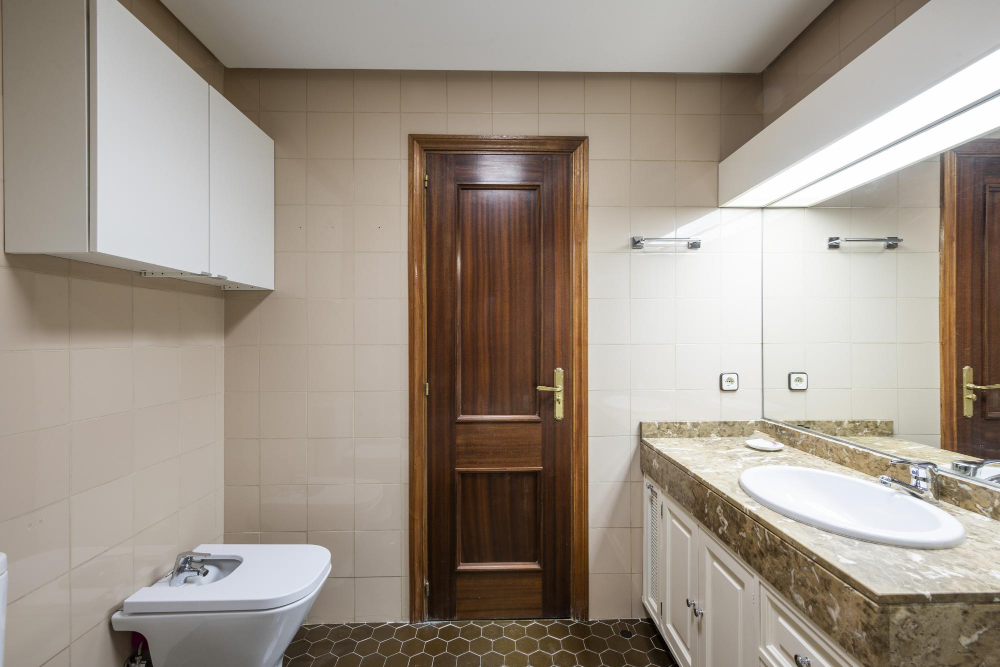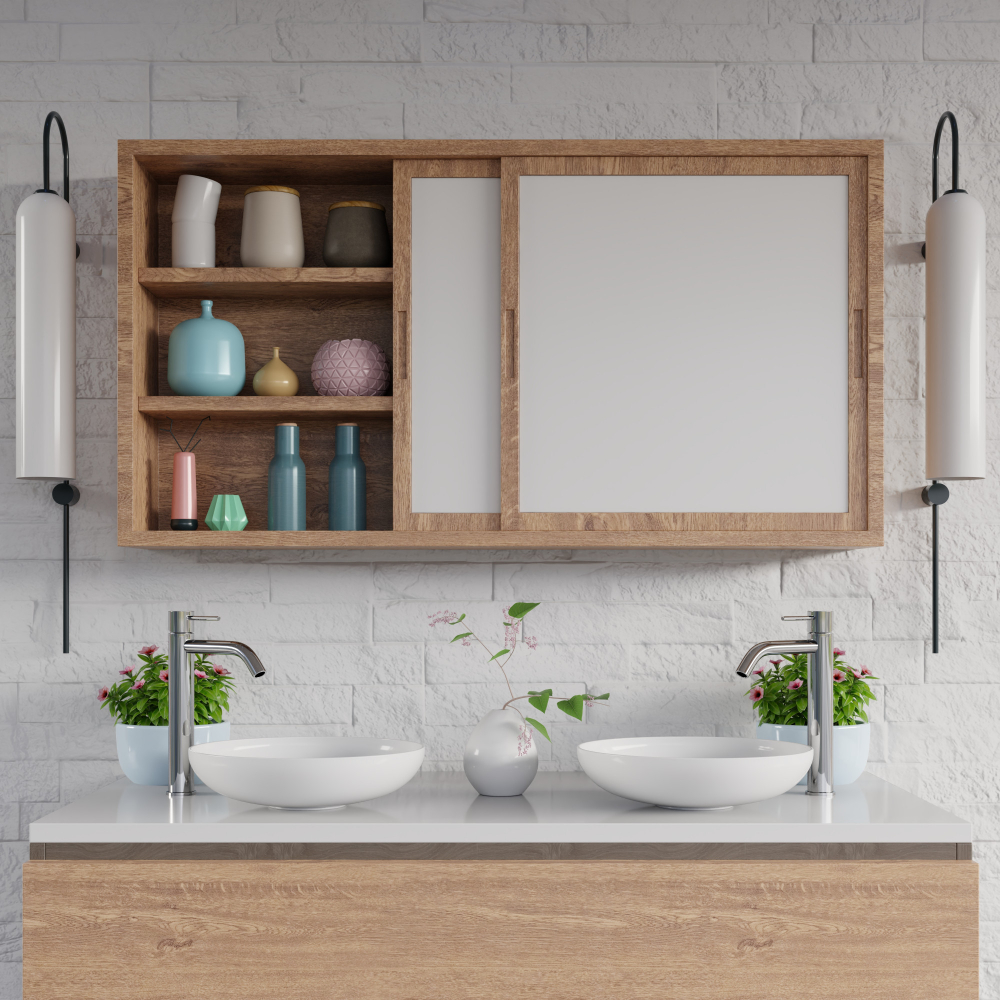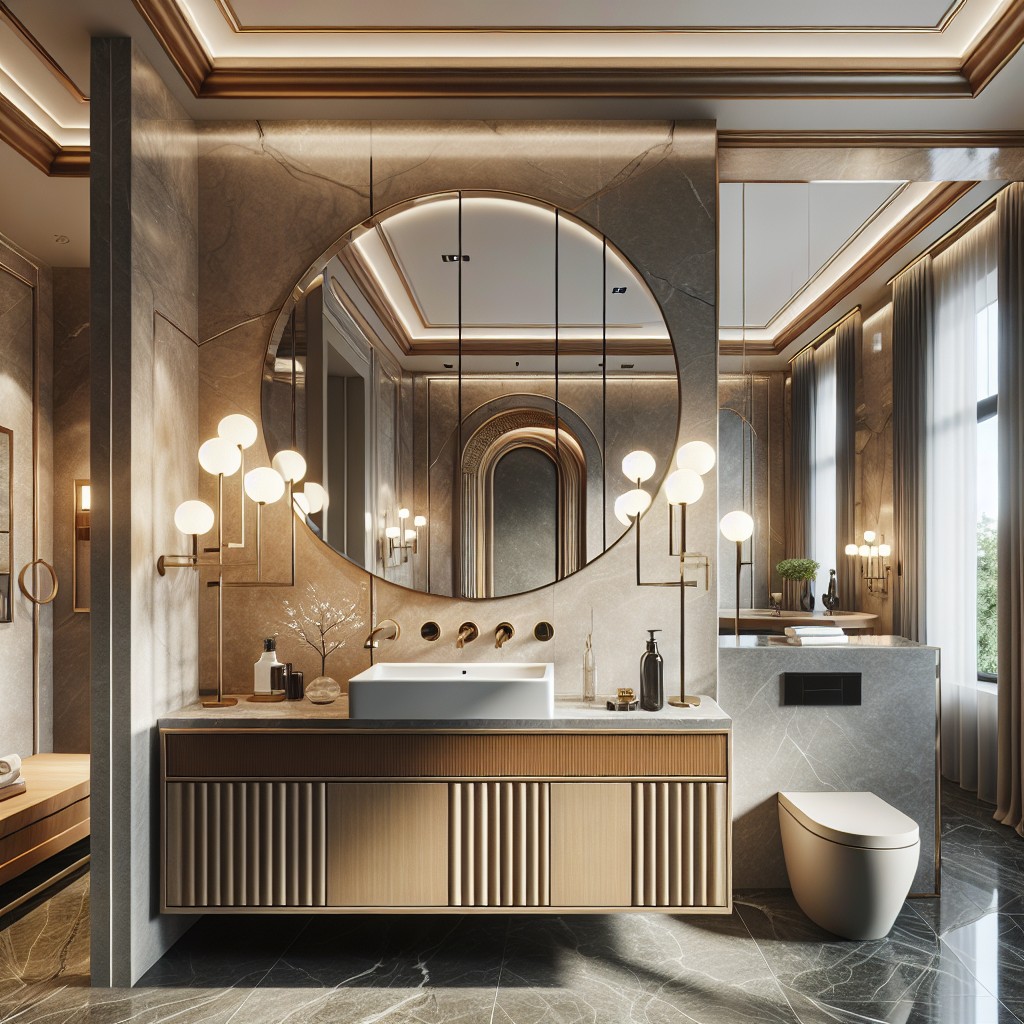Last updated on
Discover the versatility of kitchen cabinets as we explore their potential for transforming your bathroom vanity into a stylish and functional space.
Are you planning to renovate your bathroom and wondering if you can use kitchen cabinets for a bathroom vanity? Well, you’re not alone. Many homeowners have asked this question, and the answer is not as straightforward as it may seem.
While some people believe that kitchen cabinets can be used in the bathroom, others think it’s a terrible idea. In this article, we’ll explore the pros and cons of using kitchen cabinets for your bathroom vanity and help you make an informed decision.
So, let’s dive in!
Key takeaways:
- Kitchen cabinets can be used as bathroom vanities with some considerations.
- Kitchen cabinets are designed for heavy-duty use and come in various styles.
- Bathroom vanities require more moisture-resistant materials.
- Kitchen cabinets offer cost-effectiveness and ample storage space.
- There are pros and cons to using kitchen cabinets in the bathroom.
What's Inside
Understanding Bathroom Vanity Functions

Before we dive into the pros and cons of using kitchen cabinets for bathroom vanities, it’s essential to understand what a bathroom vanity is and its functions. A bathroom vanity is a piece of furniture that typically includes a sink or basin, countertop, storage space in the form of drawers or cabinets, and sometimes mirrors.
It serves as both functional storage for your toiletries and other essentials while also adding style to your bathroom decor.
Bathroom vanities come in various sizes, styles, materials such as wood or stone countertops with different finishes like matte black hardware or brushed nickel faucets. They can be freestanding units that sit on the floor with legs attached at each corner; wall-mounted units that hang from brackets mounted on walls; built-in units designed to fit within an alcove between two walls.
Comparing Kitchen Cabinets and Bathroom Vanities

While both serve as storage solutions, they differ in terms of design, materials used, and functionality.
Kitchen cabinets are designed for heavy-duty use since they need to withstand the weight of dishes and appliances. They come in various sizes and styles that cater to different needs.
On the other hand, bathroom vanities tend to be smaller than kitchen cabinets since bathrooms usually have limited space.
Bathroom vanities also require more attention when it comes to moisture resistance due to their proximity with water sources such as sinks or showers. This is why most bathroom vanity manufacturers use materials like PVC or MDF boards that can withstand humidity better than regular wood.
Biggest Differences Between Kitchen Cabinets and Bathroom Vanities

The most notable difference is the environment in which they will be used. Bathrooms are typically more humid than kitchens, so materials that can withstand moisture and humidity should be used.
Another key difference between the two is their size and design. Bathroom vanities tend to be smaller than kitchen cabinets since bathrooms usually have less space compared with kitchens.
Bathroom vanities often come with built-in sinks while this feature isn’t common in kitchen cabinetry.
Lastly, aesthetics play an important role when choosing between these two types of cabinetry as well. Kitchen cabinets may not always match the style of your existing bathroom decor or fit into its overall aesthetic seamlessly.
Pros and Cons: Kitchen Cabinets in Bathrooms

Let’s take a closer look at some of them.
Pros:
- Cost-effective: Kitchen cabinets are generally less expensive than custom-made bathroom vanities.
- Variety: There is a wide range of styles, colors, and finishes available for kitchen cabinets that can be used to create unique designs in your bathroom.
- Durability: Kitchen cabinetry is designed to withstand heavy use and moisture exposure, making it an excellent choice for bathrooms.
- Storage space: With their deep drawers and shelves, kitchen cabinets offer ample storage space that can help keep your bathroom organized.
Cons:
- Height issues: Most standard-sized kitchen base units are taller than typical vanity height. This means you may need to modify or adjust the cabinet’s height before installation.
- Limited customization options: While there are many different styles available for kitchens’ cabinetry, they may not always fit with your desired aesthetic or design scheme as well as custom-built vanities would do so perfectly
- Maintenance requirements – Since these were not specifically made for bathrooms; they might require more maintenance compared to traditional bath vanities
Pros of Using a Kitchen Cabinet for Bathroom Vanity

Kitchen cabinets are often less expensive than custom-made bathroom vanities, and they come in a wide range of sizes, styles, and finishes to suit any taste or budget.
Another benefit is that kitchen cabinets offer ample storage space for all your toiletries and other essentials. They typically have more drawers and shelves than traditional bathroom vanities, making it easier to organize your items.
Kitchen cabinets also tend to be sturdier than standard bathroom vanities since they’re designed to hold heavy pots, pans, dishes – which means you won’t have to worry about them breaking down easily under the weight of your countertop sink or other fixtures.
Lastly but not least important: by repurposing old kitchen cabinetry into new vanity units you can help reduce waste while giving an outdated piece a second life!
Cons of Using a Kitchen Cabinet for Bathroom Vanity

First and foremost, kitchen cabinets are not designed to withstand the humid environment of bathrooms. Bathrooms tend to be more humid than kitchens due to the presence of showers and baths that generate steam.
This humidity can cause wood-based materials used in kitchen cabinets such as MDF or particleboard, which is not moisture-resistant, to warp or swell over time.
Another disadvantage is that most standard-sized kitchen base cabinets are taller than bathroom vanities by several inches. This difference in height can make it difficult for shorter individuals or children who may struggle with reaching the sink comfortably.
Lastly, while you might save money on purchasing a cheaper cabinet from your local home improvement store instead of buying an expensive custom-made vanity cabinet specifically designed for bathrooms; however installing them requires additional work such as cutting holes into drawers and doors so they fit around plumbing fixtures properly.
Benefits of Using Kitchen Cabinets in the Bathroom

Firstly, kitchen cabinets are designed to be durable and withstand heavy use, which makes them perfect for high-traffic areas like bathrooms. They are made from sturdy materials such as hardwood or plywood and can last for many years without showing signs of wear and tear.
Secondly, using kitchen cabinets in the bathroom is cost-effective compared to buying custom-made vanities. Kitchen cabinets come in various sizes and styles that can fit any budget range while still providing ample storage space.
Thirdly, using a kitchen cabinet as your bathroom vanity allows you to customize your space according to your taste. You have more options when it comes to choosing colors, finishes, hardware styles than traditional pre-built vanities offer.
Lastly but not least important benefit is sustainability: repurposing old or unused cabinetry reduces waste by keeping these items out of landfills while also saving money on new purchases.
Materials Suitable for Kitchen Cabinets and Bathroom Vanities

Not all materials are suitable for both spaces. While kitchen cabinets can be made from a variety of wood species and finishes, bathroom vanities require more durable and moisture-resistant materials due to the high humidity levels in bathrooms.
Some of the most popular material choices for bathroom vanities include solid surface countertops like quartz or granite, porcelain tiles, marble slabs or tiles as well as engineered stone surfaces such as Corian®. For cabinet doors and drawers fronts that will withstand water exposure without warping over time; you may want to consider using MDF (medium-density fiberboard), PVC (polyvinyl chloride) wrapped doors/drawer fronts with waterproof adhesive joints.
On the other hand, when it comes to kitchen cabinets which don’t have direct contact with water on a regular basis but still need durability against wear-and-tear from daily use; hardwoods like oak maple cherry birch hickory alder walnut etc., laminates such as Formica®, Thermofoil®, Melamine® among others can be used effectively.
Choosing the Right Kitchen Cabinet for a Bathroom Vanity

First and foremost is the size of the cabinet. You want to make sure that it fits comfortably in your bathroom without taking up too much space or looking out of place.
Another important consideration is the material used in making the kitchen cabinets. Bathroom vanities are exposed to moisture and humidity, so you need a material that can withstand these conditions without warping or deteriorating quickly.
Wooden cabinets made from hardwoods like oak, maple, cherry or birch are popular choices because they’re durable and attractive. However, if you’re on a tight budget but still want something stylish yet functional for your bathroom vanity project then MDF (medium-density fiberboard) may be an option worth considering as well.
Lastly, think about how you’ll customize your chosen kitchen cabinet into a suitable bathroom vanity design-wise; this includes selecting hardware such as handles/knobs/pulls which will complement both its style & functionality while also matching any existing fixtures already present within said room (e.g., faucets).
Adapting Kitchen Cabinets for Bathroom Vanity Use

First, ensure that the cabinet is the right size and shape for your bathroom space. You may need to modify it by cutting or trimming some parts.
Secondly, make sure that the material used in constructing the kitchen cabinet can withstand moisture and humidity levels typical of bathrooms. Materials like MDF (medium-density fiberboard) are not suitable because they tend to swell when exposed to water.
Thirdly, choose a countertop material that complements both your kitchen cabinets and bathroom decor while also being durable enough for daily use in a wet environment.
Lastly, don’t forget about plumbing considerations such as sink placement and drain location when adapting your kitchen cabinet into a functional bathroom vanity.
Installation Tips: Kitchen Cabinets As Bathroom Vanities

While it may seem like a straightforward process, there are some things to keep in mind.
Firstly, ensure that the cabinet is level and secure before attaching it to the wall. Use shims if necessary and make sure all screws are tightened properly.
Secondly, consider plumbing requirements when installing your new vanity. You may need to cut holes in the back of the cabinet for pipes or adjust them accordingly.
Thirdly, choose appropriate hardware such as drawer pulls and knobs that can withstand moisture levels commonly found in bathrooms.
Lastly, seal any gaps between walls and cabinets with silicone caulk or other waterproof materials for added protection against water damage over time.
Customizing Kitchen Cabinets for Bathroom Vanity Aesthetics

You can choose from a wide range of finishes and colors that match your bathroom’s theme. For instance, if you have a modern or contemporary bathroom design, consider using high-gloss white or black kitchen cabinets with sleek hardware.
You may also want to add some decorative elements such as crown molding or trim pieces to give the cabinet a more polished look. Installing glass doors on some of the upper cabinets will create an illusion of space while providing storage for towels and other toiletries.
Another way to customize your kitchen cabinet is by adding legs instead of mounting it directly on the wall. This will make it look like furniture rather than just another piece in your bathroom.
Customizing kitchen cabinets for use as a bathroom vanity allows homeowners greater flexibility in creating their ideal space without breaking their budget.
How to Make a Vanity Out of a Kitchen Cabinet

Fortunately, it’s not as complicated as it may seem. With some basic tools and materials, you can easily turn a kitchen cabinet into a stylish and functional bathroom vanity.
Firstly, choose the right size of the kitchen cabinet that will fit in your bathroom space without looking too bulky or cramped. You’ll also need to select an appropriate countertop material that is suitable for use in bathrooms.
Next up is cutting out holes on top of the counter where sinks will go if necessary; this should be done by professionals unless one has experience with power tools like jigsaws or circular saws.
Afterward comes attaching plumbing fixtures such as faucets and drains onto their respective positions before installing them under cabinets so they don’t interfere with drawers’ movement when opened/closed repeatedly over time due to wear-and-tear effects caused by water exposure from daily usage habits like washing hands/face etcetera which could lead to rusting metal parts if left unchecked over long periods without proper maintenance routines being followed regularly enough (e.g., cleaning off any debris buildup).
Should Your Kitchen and Bathroom Cabinets Match?

One of the most common questions homeowners ask when considering using kitchen cabinets for their bathroom vanity is whether or not they should match their kitchen cabinets. While there’s no hard and fast rule, it’s generally a good idea to keep your cabinetry consistent throughout your home.
Matching your kitchen and bathroom cabinets can create a cohesive look that ties together the design elements in both spaces. It also makes sense from a practical standpoint since you’ll likely be storing similar items in both areas.
However, if you’re looking to create distinct looks for each space, then mixing up the cabinetry could work well too. For example, if you have dark wood cabinets in your kitchen but want something lighter and brighter for your bathroom vanity area, then opting for white or light-colored cabinetry could be an excellent choice.
Ultimately it comes down to personal preference as well as what works best with the overall design scheme of your home.
Proper Maintenance for Kitchen Cabinets in a Bathroom

Bathrooms are high-moisture areas, and the humidity can cause damage to wood materials over time. To prevent this from happening, make sure that your bathroom is well-ventilated by installing an exhaust fan or opening windows after showering.
Avoid using harsh cleaning products on your kitchen cabinets as they can strip off the finish and cause discoloration. Instead, use mild soap and water or a specialized cleaner designed for wood surfaces.
Another important aspect of maintaining kitchen cabinets in a bathroom is preventing water damage. Make sure that any leaks are fixed promptly and wipe up any spills immediately with a dry cloth.
Some Things to Consider

First and foremost, make sure that the cabinet is made of materials suitable for a bathroom environment. Bathrooms are often humid and prone to moisture buildup, which can cause damage over time if the material is not water-resistant.
Another thing to keep in mind is the size of your bathroom. Kitchen cabinets tend to be larger than traditional vanities, so it’s essential that you measure your space carefully before making any purchases or modifications.
You should also think about how much storage space you need in your vanity. While kitchen cabinets offer ample storage options with their deep drawers and shelves, they may not be as functional when it comes down specifically for storing toiletries or other small items commonly found in bathrooms.
Lastly but most importantly – safety! Make sure that all electrical outlets near where plumbing will take place have GFCI protection installed by a licensed electrician before starting any work on this project!
Cost and Final Considerations

While it may seem like an affordable option, there are some additional costs you need to keep in mind. For instance, you’ll need to purchase a countertop and sink separately since most kitchen cabinets don’t come with them.
Moreover, if the cabinet needs any modifications or customization for bathroom use such as drilling holes for plumbing fixtures or adding shelves and drawers, this will add up more expenses.
Another thing worth considering is that using kitchen cabinets in the bathroom might affect your home’s resale value negatively. Potential buyers may not appreciate seeing mismatched cabinetry throughout their new home.
While using kitchen cabinets as a bathroom vanity can be cost-effective and stylish at first glance; it’s essential also to weigh all factors before making this decision carefully.
Real-life Examples of Bathroom Vanities Made From Kitchen Cabinets

Many homeowners have successfully used kitchen cabinets to create unique and stylish bathroom vanities that perfectly suit their needs. For instance, a homeowner in California transformed an old oak cabinet into a beautiful double sink vanity for her master bath by adding some custom drawers and shelves.
Another homeowner in Texas repurposed an antique hutch as a single sink vanity with plenty of storage space.
If you’re looking for inspiration, there are many online resources where you can find photos and tutorials on how to turn your kitchen cabinets into stunning bathroom vanities. Pinterest is one such platform where users share their DIY projects, including before-and-after pictures of their converted cabinetry.
However, keep in mind that not all kitchens or bathrooms are created equal; what works well for someone else may not work well for your specific situation. So it’s essential to consider factors like size limitations, plumbing requirements, materials needed before embarking on any project involving converting kitchen cabinets into bathroom vanities.
Final Thoughts

It’s essential to consider the pros and cons before making a final decision. While it may seem like an easy way to save money on your renovation project, you need to ensure that the cabinet is suitable for use in a damp environment such as the bathroom.
If you decide to go ahead with this option, make sure that you choose high-quality materials and hardware designed specifically for bathrooms. You should also hire professional installers who have experience working with both kitchen cabinets and bathroom vanities.
Whether or not using kitchen cabinets as your new bathroom vanity is right for you depends on several factors such as budget constraints, personal preferences in style and functionality of space among others. However; by following these tips outlined above will help ensure success when transforming your old boring bath into something beautiful!
FAQ
Can you make a bathroom vanity with kitchen cabinets?
Yes, you can make a bathroom vanity with kitchen cabinets, but it requires time, effort, and cost may vary based on multiple factors.
Is there a difference between kitchen cabinets and bathroom cabinets?
Yes, there is a difference between kitchen and bathroom cabinets, as bathroom cabinets are typically shorter at 31 inches and shallower with a standard depth of 21 inches, compared to kitchen cabinets with a standard height of 34 inches and a depth of 24 inches.
Can you put a wood cabinet in the bathroom?
Yes, you can put a solid wood cabinet like oak or maple in the bathroom, provided it is properly sealed, painted, and there is adequate ventilation for humidity to escape.
Can I use Ikea kitchen cabinets in my bathroom?
Yes, you can use Ikea kitchen cabinets in your bathroom, as they provide a versatile solution for bathroom storage, like the Sektion line used in a renovation project.
What are the key factors to consider when converting kitchen cabinets into a bathroom vanity?
Key factors to consider when converting kitchen cabinets into a bathroom vanity include ensuring proper size, plumbing compatibility, moisture resistance, and storage functionality.
How can you effectively protect wooden cabinets from humidity and moisture in the bathroom?
To effectively protect wooden cabinets from humidity and moisture in the bathroom, apply water-resistant sealant or paint and install a proper ventilation system.
What types of kitchen cabinet materials are suitable for bathroom usage?
Suitable kitchen cabinet materials for bathroom usage include water-resistant options such as PVC, stainless steel, and marine-grade plywood.




